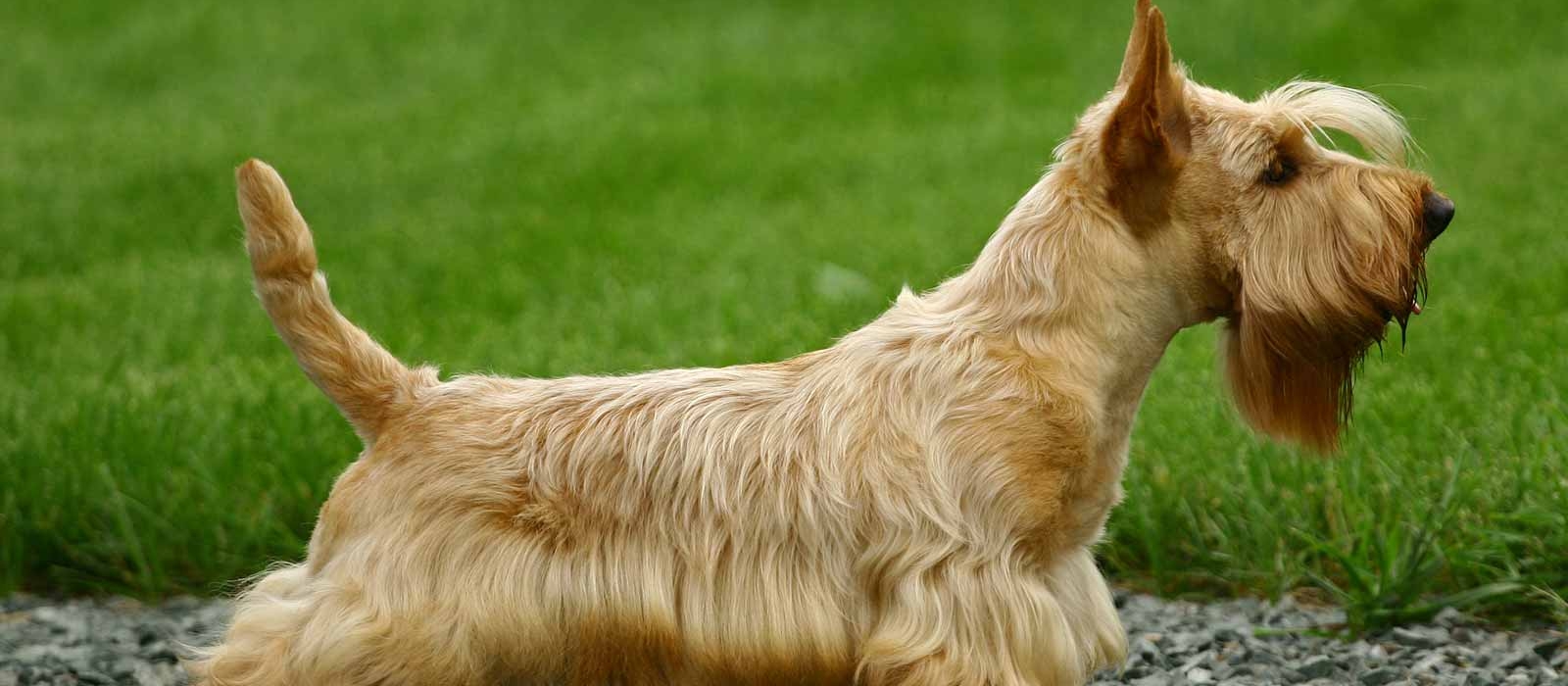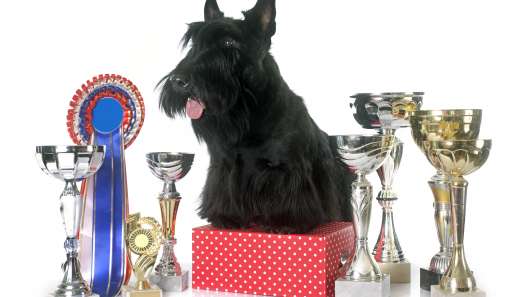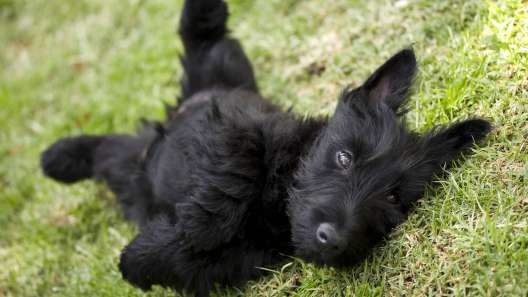-
Activity Level:
high
-
Shedding Level:
low
-
Grooming Level:
high
-
Trainability:
moderate
-
Good for Novice Owners:
moderate
-
Adaptability:
high
-
Kid/Pet Friendly:
often
-
Prey Drive:
high
-
Watchdog:
very alert
- Average Size: Small
- Average Lifespan: 12 years
- Registered?: aca, akc
Scottish Terrier Dog Breed Information
Overview
Temperament
Adaptability
Health
Owner Experience
Grooming
Activity Level
Size
Life Span
Did You Know?
The Scottish Terrier, nicknamed the “Scotland Kid” and also known as the Aberdeen Terrier, is one sturdy and valiant terrier. One of the most popular show dog breeds over the years at the Westminster Kennel Club Show, last winning Best in Show in 2010, the hypoallergenic Scottish Terrier was first recognized by the AKC in 1885.
One of the facts about Scottish Terriers is that they are one of five terrier breeds originating from Scotland (Cairn, Skye, Dandie Dinmont, and West Highland). Considered one of the oldest of the Highland terriers and potentially one of the oldest indigenous British breeds, the history of this dog breed is a long one, although it is not fully traceable.
These sturdy little dogs were originally bred to be farm dogs that could also hunt game, like badgers, rats, and foxes, through the rugged Scottish Highlands. King James I of England, who was a Scot by birth, gave Scottish Terriers as gifts during the 17th Century, which could be one of the things that helped the Scottie break out of Scotland and into the rest of the world.
The Scottie has left a mark on pop culture as well. The dog breed has been a presidential pup and the “First Dog” of the United States a few times; Presidents Dwight D. Eisenhower, Franklin D. Roosevelt, and George W. Bush all had Scottish Terriers while in the White House. And, how can we forget their role playing Jock in the all-time favorite Disney film Lady and the Tramp?
The Scottish Terrier is the definition of a fearless little sparkplug. Small in stature, but large in voice and heart, they will be an alert and effective watchdog and surely ward off intruders or even startle the occasional delivery person. This does mean they can be prone to barking a lot. Early socialization and training your dog to stop barking can help keep it from getting out of hand.
Well-socialized Scotties will love your kids, family, and friends and be a loyal companion. Provided they are well-socialized, they can be distantly cordial with other dogs, but they tend not to prefer it and can become grouchy around them. They tend to prefer sticking with their family and people they know.
They are also terriers and have a high prey drive. This means that they are likely to chase practically everything. Individual dogs can do well with other pets in the family that they have been raised with, but you will need to be prepared to do some extra training and socialization to help redirect and manage prey drive.
The Scottish Terrier is a highly adaptable dog. Their energy and urge to chase make them a good fit for homes with securely fenced yards. But, they can adapt to apartment living provided they get the daily attention, mental stimulation, and exercise they need to be happy and healthy.
Scottish Terriers are relatively indifferent when it comes to climate. As with all dogs, they are sensitive to heat. They are also pretty good at handling some cold, but they are not an Arctic breed. So, you may need to stock up on some winter dog products to keep your Scottie warm while out on winter walks.
Although they are considered an independent dog breed, this does not mean that they like alone time. They bond closely with their families and prefer to be with them. They are also energetic and easily bored, so they do not like being left alone for long periods of time. Bored or under-exercised dogs can be prone to anxious and/or destructive behavior.
Overall, the Scottish Terrier is a generally healthy breed. Potential health conditions to be aware of (and that breeders should be screening for) can include luxating patella, von Willebrand’s Disease, eye anomalies, and thyroid abnormalities. Good breeding practices and the health of the parents make a big difference in the health of Scottish Terrier puppies.
Reputable breeders will screen their dogs to make sure they are not passing preventable issues to puppies. So, make sure you talk to the breeder about the health and genetic history of the parents. You can also ask about any health tests or clearances that have been done. The Scottish Terrier Club of America recommends the Scottish Terrier-specific DNA test for von Willebrand’s Disease III (vWD III) and a patella evaluation at a minimum. The Club also recommends evaluations for the eyes and the thyroid.
The Scottish Terrier is not recommended if you are a novice dog owner, unless you intend to invest in puppy training classes or the help of a dog trainer. These dogs are highly intelligent. Although they can be eager to please, they can also be stubborn and are independent thinkers known to push boundaries.
If you can get past their stubborn side, you will find the Scottie very receptive to training and learning new things. Scotties pick up on things quickly and are bored easily, especially with repetition. And, they are known for not responding when they are bored with training. Being creative with training, keeping sessions short, and continually learning new things can help keep your dog engaged during training sessions.
If you can make your request seem like their idea, their independent mind will work in your favor. Be aware that the Scottish Terrier takes both praise and criticism very much to heart, so be careful not to let frustration get the best of you because the Scottie will know it. Harsh tones or corrections can damage your bond with them.
The Scottish Terrier most often has a Black coat, but can also come in Wheaten and a variety of Brindle colors. They have a double coat. The undercoat is dense and soft, while the outer coat is wiry. Ideally, it is recommended to hand strip this coast weekly to get it started, and then monthly with weekly brushing and combing to maintain it after that. You can learn to do this yourself or find a dog groomer who specializes in hand-stripping coats.
If hand-stripping isn’t doable, you can clip the coat. However, it is important to note that your Scottie’s coat will lose its harsh texture, and the soft undercoat will take over. If you end up needing to clip your Scottish Terrier’s coat, it will need to be done every 6-8 weeks. Bathing can occur during these sessions as well, as the Scottie will only need periodic baths.
In addition to coat care, you will also need to take care of your Scottish Terrier’s nails, ears, and teeth. Once or twice monthly nail trims are usually enough to keep them from growing too long. Weekly ear checks, in addition to careful cleanings when needed, can help prevent ear infections. Daily dental care, along with cleanings at the vet when needed, can help prevent dental diseases later in life.
The Scottie is a high-energy terrier. Daily walks, plus some playtime and time to run, are a minimum for this breed. They tend to be playful and energetic in bursts. They will also often be up for more activity if you are.
Despite their short legs and small stature, these little dogs are sturdy and athletic. They tend to enjoy games of fetch or catch, tug-of-war, and more. Scottish Terriers also excel at several popular dog sports, including competitive agility. Just make sure to keep their activities low-impact until puppies finish growing to avoid damaging developing bones and joints.
Fully-grown Scottish Terriers usually stand 10 inches tall and weigh 18-22 pounds. Females usually average 18-21 pounds, while males usually average 19-22 pounds.
Scottish Terriers generally live for 12 years on average.
President Franklin D. Roosevelt’s Scottie, Fala, was a constant companion during World War II and is considered history’s most famous Scottish Terrier. This is also why the peak popularity for this dog breed in the United States was during the 1930s and ‘40s. Some celebrities at the time, like Bette Davis and Humphrey Bogart, also had Scotties, which also contributed to their popularity.









